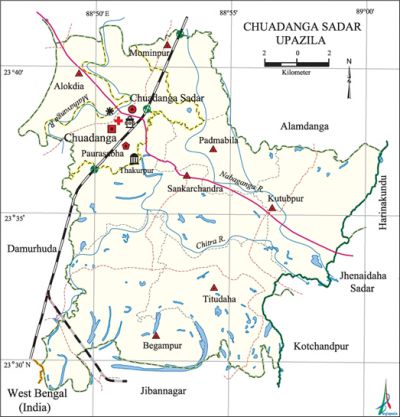Chuadanga Sadar Upazila
Chuadanga Sadar Upazila (chuadanga district) area 298.27 sq km, located in between 23°29' and 23°42' north latitudes and in between 88°47' and 89°00' east longitudes. It is bounded by alamdanga upazila on the north, jibannagar upazila on the south, jhenaidah sadar, kotchandpur and harinakunda upazilas on the east, damurhuda upazila and west bengal state of India on the west.
Population Total 313935; male 156782, female 157153; Muslim 305290, Hindu 8422, Buddhist 17, Christian 172 and others 34.
Water bodies Main rivers: Mathavanga, nabaganga, chitra and bhairab.
Administration Chuadanga upazila was established in 1984. Although Chaudanga municipality was formed in 1960 it began functioning in 1965.
| Upazila | ||||||||
| Municipality | Union | Mouza | Village | Population | Density (per sq km) | Literacy rate (%) | ||
| Urban | Rural | Urban | Rural | |||||
| 1 | 7 | 89 | 127 | 128865 | 185070 | 1052 | 51.59 (2001) | 40.8 |
| Municipality | ||||||||
|
Area |
Ward |
Mahalla |
Population |
Density |
Literacy rate (%) | |||
| 37.37 (2001) | 9 | 43 | 85786 | 2072 (2001) | 61.7 | |||
| Upazila Town | ||||||||
|
Area |
Mouza |
Population |
Density |
Literacy rate (%) | ||||
| 31.64 (2001) | 8 | 43079 | 1154 (2001) | 48.6 | ||||
| Union | ||||
| Name of union and GO code | Area (acre) | Population | Literacy rate (%) | |
| Male | Female | |||
| Alokdia 11 | 4798 | 14364 | 14476 | 48.9 |
| Kutubpur 47 | 10395 | 16604 | 16627 | 44.1 |
| Titudaha 83 | 12704 | 20485 | 20655 | 42.6 |
| Padmabila 62 | 5557 | 10173 | 10041 | 44.7 |
| Begampur 23 | 13692 | 20669 | 21089 | 37.0 |
| Mominpur 59 | 4236 | 7787 | 7864 | 38.6 |
| Shankarchandra 71 | 13089 | 23760 | 23555 | 41.3 |
Source Bangladesh Population Census 2001 and 2011, Bangladesh Bureau of Statistics.

Archaeological heritage and relics Three domed Chuadanga Bara Mosque, Thakurpur Mosque (1698), Bara Shalua Mosque.
War of Liberation During the war of liberation in 1971 Chuadanga Sadar Hospital was the district headquarter of the Pak army. The Pak army brutally killed about 300 innocent persons at the backyard of the Hospital (present Shantipara). Freedom fighters had encounters with Pak army at Kalupole Katermath, Dumuria channel, Jalshuka. Chandpur Shailogari Math, Begumpur Colonipara, Shibnagar and some other places of the upazila. A mass grave has been discovered at Shantipara village of the upazila.
For details: see চুয়াডাঙ্গা সদর উপজেলা, বাংলাদেশ মুক্তিযুদ্ধ জ্ঞানকোষ (Encyclopedia of Bangladesh War of Liberation), বাংলাদেশ এশিয়াটিক সোসাইটি, ঢাকা ২০২০, খণ্ড ৩।
Religious institutions Mosque 218, temple 3, church 1, tomb 10, most noted of which are Bara Mosque, Thakurpur Mosque.
Literacy rate and educational institutions Average literacy 47.6%; male 48.8%, female 46.5%. Educational institutions: college 4, secondary school 27, technical school 1, madrasa 8. Noted educational institutions: V G (Victoria Jubilee) Government High School (1880), Badarganj Alia Madrasa (1962)
Newspapers and periodicals Daily: Mathavanga, Prothom Rajdhani; weekly: Chuadanga Darpan, Chuadanga Samachar, Din Badaler Kagaj.
Cultural organisations Library 2, club 35, theatre group 11, cinema hall 3, theatre stage 2, women's organisation 2, press club 1.
Main sources of income Agriculture 56.80%, non-agricultural labourer 3.29%, industry 1.40%, commerce 16.20%, transport and communication 5.24%, service 7.92%, construction 1.96%, religious service 0.17%, rent and remittance 0.46%' and others 6.56%.
Ownership of agricultural land Landowner 51.94%, landless 48.06%; agricultural landowner: urban 44.91% and rural 56.09%.
Main crops Paddy, jute, sugarcane, wheat, betel leaf, cotton, corn, oil seed, vegetables.
Extinct or nearly extinct crops Sesame, linseed, tobacco, aus paddy.
Main fruits Mango, coconut, jackfruit, guava, banana, papaya.
Fisheries, dairies and poultries Dairy 11, Poultry 35.
Communication facilities Pucca road 197.37 km, semi-pucca road 42.49 km, mud road 254.43 km; railway 17 km; waterway 51 km. Bridge 61, culvert 447.
Extinct or nearly extinct traditional transport Palanquin, horse carriage.
Noted manufactories Rice mill 17, chira (threshed) mill 7, pulse mill 5, flour mill 3, metal workshop 22, biscuit factory 15, shoe factory 2.
Cottage industries Goldsmith, blacksmith, potteries, embroidery, bamboo work, wood work.
Hats, bazars and fairs Hats and bazars are 27, most noted of which are Sarojganj Bazar, Dingedaha Bazar, Hijlagari Bazar, Kedarganj Bazar, Alokdia Bazar, Gokulkhali Bazar, Bhalaipur Bazar, Bara Bazar and Dingedaha Merete Mela, Garuitupir Mela.
Main exports Rice, banana, betel leaf, mango, jackfruit, date molasses, biscuit, vegetables.
Access to electricity All the wards and unions of the upazila are under rural electrification net-work. However 65.4% of the dwelling households have access to electricity.
Sources of drinking water Tube-well 89.5%, tap 8.8%, and others 1.7%. The presence of intolerable level of arsenic has been detected in shallow tube-well water of the upazila.
Sanitation 45.7% of dwelling households of the upazila use sanitary latrines and 48.1% of dwelling households use non-sanitary latrines; 6.2% of households do not have latrine facilities.
Health centres Hospital 1, upazila health complex 1, union health and family welfare centre 7, satellite clinic 1, chest diseases hospital 1, diabetic hospital 1, infectious diseases hospital 1, eye hospital 1, maternity and child care centre 1, community clinic 21.
Natural disasters The floods, draughts, excessive rainfall, tidal bore and cyclones of 1970, 1971, 1984, 1988, 1998 and 2001 caused huge loss of life and damages to settlements, communication facilities, crops and livestock of the upazila.
NGO activities brac, care, asa, WAVE, Chetana, Prachesta. [Md. Faysal Kibria]
References Bangladesh Population Census 2001 and 2011, Bangladesh Bureau of Statistics; Cultural survey report of Chuadanga Sadar Upazila 2007.
